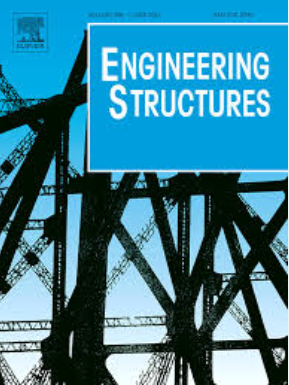三维打印混凝土的可建造性有限元分析,包括弹性屈曲破坏和塑性流动破坏
IF 6.4
1区 工程技术
Q1 ENGINEERING, CIVIL
引用次数: 0
摘要
本研究为3D打印混凝土结构的数值模拟提出了一个新的框架。为此,提出了一种再现材料老化、拉伸和压缩损伤、不可逆应变和蠕变等特性的本构模型。结合大位移框架对3D打印混凝土结构进行可建造性分析,同时考虑到弹性屈曲和塑性流动的破坏。在这项工作中,共包含了四个混凝土3D打印的数值模拟,它们都是文献报道的实验:直墙,空心圆柱形墙,大空心方形墙和小空心方形墙。结果表明,该模型能够精确再现弹性屈曲和塑性流动破坏,有效预测3D打印混凝土结构的可建造性。本文章由计算机程序翻译,如有差异,请以英文原文为准。
Finite element buildability analysis of 3D printed concrete including failure by elastic buckling and plastic flow
The present work proposes a novel framework for the numerical simulation of 3D printed concrete structures. For this, a constitutive model is proposed to reproduce the material behavior featuring aging, tensile and compressive damage, irreversible strain and creep. This is combined with a large-displacement framework to perform the buildability analysis of 3D printed concrete structures taking into account failure by both elastic buckling and plastic flow. In this work, a total of four numerical simulations of 3D printing of concrete are included, all of them being experiments reported in the literature: a straight wall, a hollow cylindrical wall, a large hollow square wall and a small hollow square wall. The results show the ability of the model to reproduce failure by elastic buckling and plastic flow with precision, effectively predicting the buildability of the 3D printed concrete structures.
求助全文
通过发布文献求助,成功后即可免费获取论文全文。
去求助
来源期刊

Engineering Structures
工程技术-工程:土木
CiteScore
10.20
自引率
14.50%
发文量
1385
审稿时长
67 days
期刊介绍:
Engineering Structures provides a forum for a broad blend of scientific and technical papers to reflect the evolving needs of the structural engineering and structural mechanics communities. Particularly welcome are contributions dealing with applications of structural engineering and mechanics principles in all areas of technology. The journal aspires to a broad and integrated coverage of the effects of dynamic loadings and of the modelling techniques whereby the structural response to these loadings may be computed.
The scope of Engineering Structures encompasses, but is not restricted to, the following areas: infrastructure engineering; earthquake engineering; structure-fluid-soil interaction; wind engineering; fire engineering; blast engineering; structural reliability/stability; life assessment/integrity; structural health monitoring; multi-hazard engineering; structural dynamics; optimization; expert systems; experimental modelling; performance-based design; multiscale analysis; value engineering.
Topics of interest include: tall buildings; innovative structures; environmentally responsive structures; bridges; stadiums; commercial and public buildings; transmission towers; television and telecommunication masts; foldable structures; cooling towers; plates and shells; suspension structures; protective structures; smart structures; nuclear reactors; dams; pressure vessels; pipelines; tunnels.
Engineering Structures also publishes review articles, short communications and discussions, book reviews, and a diary on international events related to any aspect of structural engineering.
 求助内容:
求助内容: 应助结果提醒方式:
应助结果提醒方式:


